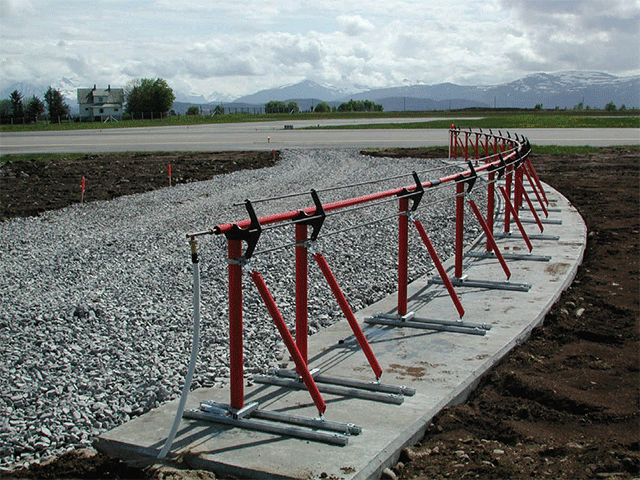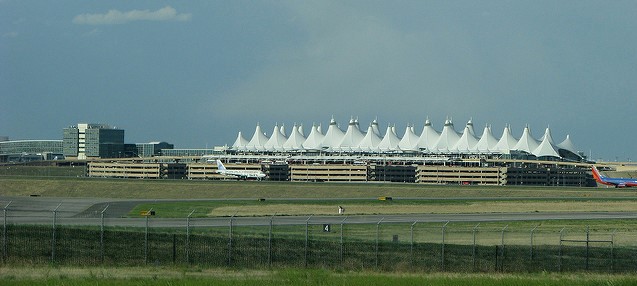What have ILS Antennas to do with airport planning, design and construction? Virtually everything! Here is why. The airdrome, built around the ILS or the hope of acquiring one, requires areas reserved for aviation purposes to remain free of structures in order to avoid interference with guidance signals relied upon by approaching aircraft. If however, airports would acquire currently available Advanced ILS Antennas that focus the radiated ILS signals-in-space rather than disperse them as do legacy antennas, then areas previously considered off limits from developing would suddenly be made available for construction projects. Airport planners and designers would then have more opportunity to develop airdromes, and areas beyond it, for greater utility, efficiency and profitability.
Unlike ILS Antenna designs of the past, modern wide aperture Advanced ILS Antennas radiate narrow, directive RF signals to approaching aircraft thereby requiring less real estate to be restricted in and around airports, to protect against interfering with guidance signals used to land. To demonstrate this, you could simply shine an adjustable beam flashlight represent an ILS Antenna’s radiated signal beam, on a table representing the airfield. As you broaden the beam, you increase the amount of illuminated area of airfield required to remain restricted for aviation purposes thereby reducing the amount of area outside the radiated beam allowable for development. This is the case with the vast majority ILS Antennas in use throughout the world today. Their narrow apertures reflect wide indiscriminate signal beams. Conversely, as you narrow the beam, you reduce the amount of illuminated restricted area and free up areas outside the beam for development much like the effects of our wide aperture Advanced ILS Antennas. With more usable real estate comes more aeronautical and non-aeronautical income development opportunities. Yet, this is only the beginning of the benefits of our wide aperture Advanced ILS Antennas.
Imagine being able to plan, design and build airport infrastructure constrained only by the limits of physical space and not by the signal behavior of any particular landing system. Or imagine installing an ILS where previously you had been told would be cost prohibitive. Imagine the efficiencies produced when aircraft and ground crews are able to move about unencumbered by ILS Critical and Sensitive Areas, pilots landing confident of uninterrupted coupled approaches and ATC managing fewer numbers of delayed surface and airborne traffic. Now, imagine saving millions on site prep excavation or environmental wetlands mitigation and turning a regional airport into a greater economic catalyst for the entire local community. With Watts’ Advanced ILS Antennas, you won’t have to imagine anymore.
…Troy Municipal Overcomes Environmental And Costs Issues With Alternative Instrument Landing System Antenna

It became clear to us, the vital role that your firms assume after learning that some years ago, the manager of Troy Alabama Municipal Airport reached out to the architectural and engineering firm Goodwyn, Mills and Cawood, to find a glide slope solution for their airport that had insufficient ground plane terrain for an imaging system. Members of the firm researched available FAA approved options, found our non-imaging glideslope antenna solution, contacted us regarding it and then advised their airport client on what they had found. Our non-imaging End-Fire Glide Slope Antenna System was chosen and installed soon after. If not for the efforts of the engineering firm, we are convinced that the airport would otherwise not have found our solution, even though the FAA was familiar with it having used it often in the past. Click on the link below to read the article in which we were credited in Airport Improvement Magazine for saving Troy Municipal Airport upwards of a million dollars with our Advanced ILS Antenna solution.
At Watts Antenna Company, we have the greatest appreciation for the many airport planners, architects and design professionals who research and analyze solutions related to airport development and modernization. Your service is invaluable to the industry as you present your findings of available solutions and design ideas to airport development teams for consideration, advocating for them in a ways that the FAA and other aviation authorities are not designated to do.
An Airport Can Have A Modern Appearance Yet Can Hardly Be Considered “Modernized” While Utilizing Antennas Of Previous Generations.
For decades, architects, planners and designers have had to creatively work around restrictions deemed necessary by aviation experts because the ILS, the workhorse in providing crucial aid to safely land aircraft in all weather conditions, utilized antennas which reflected very broad RF signal patterns. These reflected signals were to remain free of interference from structures and movements because they were relied upon by pilots to assist in landing their aircraft. Early on, these restrictions weren’t much of a problem but as demand for air traffic increased and airports added more infrastructure to keep up with demand, airport planners and designers had to become more creative to find ways to allow for airport improvements and expansion efforts to keep from interfering with guidance signals also referred to as the Signal-in-Space (SIS).
Since then, standard ILS antennas have changed very little and as a result, airport development remains subject to the same restrictions as decades before. The primary reason for this is that some within the aviation community, rather than to encourage innovations in technologically advanced ILS antennas, chose to move away from ILS in favor of more modern technologies to replace the ILS. After decades of attempts to replacing it, the ILS remains the safest most relied upon system to land aircraft throughout the world. Even with the myriad of modern augmented GNSS landing systems commercial pilots still believe the ILS to be “the gold standard” of all weather landing systems for safety, confidence and reliability. At Watts Antenna Company, we manufacture the most technologically advanced ILS Antennas in the world.
There remain no defensible reasons, for airports that have outgrown the throughput capacity of their standard ILS antenna systems to suffer high levels of flight delays as Advanced ILS Antennas are available to increase throughput capacity to avoid unnecessary congestion. By increasing the number of air operations per hour, the airport’s return on investment would be phenomenal safety would improve and construction opportunities would increase. You will discover that malformations in airport development caused by failure to upgrade the ILS Antenna system when it first began to hinder airport capacity, can now begin to be corrected. Things like hangers, built in areas to avoid RF signal interference instead of where they offer the maximum efficiency, terminals built at angles and having to be designed in such a way as to keep from interfering with the RF signal-in-space, otherwise optimal spaces for development lying vacant for fear of causing perturbation of the RF signal, safety equipment staged further from runways than is necessary, and the list goes on. Even construction outside the airport is limited by the constraints of standard ILS antennas. All of these issues have become unnecessary now that we have Advanced ILS Antenna Systems. Most importantly, our Advanced ILS Antennas re-establish safety as priority one!

Multi-taxi surface congestion occurrence shown at Chicago O’Hare International Airport, demonstrating a need for the increased throughput capacity our advanced antenna systems can provide. (Picture by Etienne du Plessis.)
Imagine being able to plan, design and build airport infrastructure constrained only by the limits of physical space and not by the signal behavior of any particular landing system. Or imagine installing an ILS where previously you had been told would be cost prohibitive. Imagine the efficiencies produced when aircraft and ground crews are able to move about unencumbered by ILS Critical and Sensitive Areas, pilots landing confident of uninterrupted coupled approaches and ATC managing fewer numbers of delayed surface and airborne traffic. Now, imagine saving millions on site prep excavation or environmental wetlands mitigation and ending up turning a regional airport into an economic catalyst for the entire local community.
Intrigued? You don’t have to imagine these capabilities; you can get them! They are available right now from Watts Antenna Company. We have ILS solutions for all airport environments. From mountaintops to seaside locations, we can provide you a high-performance Advanced ILS solution.
Watts Antenna Company manufactures high performance advanced ILS Antenna systems that can be utilized to increase airport capacity and efficiency or simply to provide ILS at the world’s toughest sites. For stand alone ILS Antenna System solutions or as comparable performance backup antenna systems for GPS/GNSS, should GNSS ever become sufficiently reliable. Either way, we will significantly increase the efficiency and capabilities of every airport in which our antennas are installed!

Reshaping Modern Airport Environments
There are new technological advances in Instrument Landing System (ILS) antennas that so dramatically alter airport environments that industry professionals will need to change the way in which they visualize their projects. So, before going one step further with ANY plans for ANY airport ANWHERE on Earth, make sure you discover the advantages of Advanced ILS Antennas from Watts Antenna Company.
The Advantages of Installing Advanced ILS Antennas From Watts
- Financial Benefits – Increase Aeronautical and non-Aeronautical Revenues
- Operational Benefits – Increase Airport Safety and Efficiency
- Environmental Benefits – Lower Energy Consumption, Greenhouse Gas Emissions, Aircraft Noise and Wildlife Habitat Disturbances.
How can we help? By providing advanced high efficiency narrow radiating ILS antennas to replace the ordinary efficiency wide radiating antennas so that more of the airport is opened up for development. You can then expand your plans to include more aeronautical and non-aeronautical revenue while helping to improve airport efficiency, improve overall airport operational safety. mitigate environmental issues, lower fuel consumption, lower greenhouse gas emissions, reduce flight delays, shorten landing and takeoff times and provide air travelers a more enjoyable experience.
Watts Antenna Company’s Advanced ILS Antennas also allow you to complete projects in shorter times with lower construction costs because we correctly address the main source of interference.
Subscribe to our newsletter at the bottom of the page for up to date information and insights on how we can effect positive change in aviation for the benefit of all stakeholders throughout the world!
WATTS ANTENNA COMPANY
70 North Plains Road – Suite H
The Plains, Ohio 45780-1156
USA – Manufacturing Facility
Phone: +1.740.797.9380; Fax: +1.740.797.9787
EMAIL: INFO@WATTSANTENNA.COM
